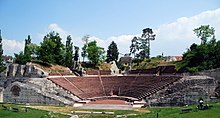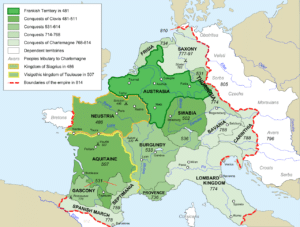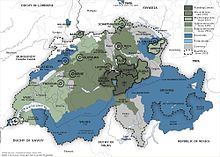

The first and second century AD was an age of prosperity for the population living on the Swiss plateau. Several towns, like Aventicum, Iulia Equestris and Augusta Raurica, reached a remarkable size, while hundreds of agricultural estates (Villae rusticae) were founded in the countryside.
Around 260 AD, the fall of the Agri Decumates territory north of the Rhine transformed today’s Switzerland into a frontier land of the Empire. Repeated raids by the Alamanni tribes provoked the ruin of the Roman towns and economy, forcing the population to find shelter near Roman fortresses, like the Castrum Rauracense near Augusta Raurica. The Empire built another line of defence at the north border (the so-called Donau-Iller-Rhine-Limes), but at the end of the fourth century the increased Germanic pressure forced the Romans to abandon the linear defense concept, and the Swiss plateau was finally open to the settlement of Germanic tribes.
In the Early Middle Ages, from the end of the 4th century, the western extent of modern-day Switzerland was part of the territory of the Kings of the Burgundians. The Alemanni settled the Swiss plateau in the 5th century and the valleys of the Alps in the 8th century, forming Alemannia. Modern-day Switzerland was therefore then divided between the kingdoms of Alemannia and Burgundy. The entire region became part of the expanding Frankish Empire in the 6th century, following Clovis I‘s victory over the Alemanni at Tolbiac in 504 AD, and later Frankish domination of the Burgundians.

Throughout the rest of the 6th, 7th and 8th centuries the Swiss regions continued under Frankish hegemony (Merovingian and Carolingian dynasties). But after its extension under Charlemagne, the Frankish Empire was divided by the Treaty of Verdun in 843. The territories of present-day Switzerland became divided into Middle Francia and East Francia until they were reunified under the Holy Roman Empire around 1000 AD.
By 1200, the Swiss plateau comprised the dominions of the houses of Savoy, Zähringer, Habsburg, and Kyburg. Some regions (Uri, Schwyz, Unterwalden, later known as Waldstätten) were accorded the Imperial immediacy to grant the empire direct control over the mountain passes. With the extinction of its male line in 1263, the Kyburg dynasty fell in AD 1264; then the Habsburgs under King Rudolph I (Holy Roman Emperor in 1273) laid claim to the Kyburg lands and annexed them extending their territory to the eastern Swiss plateau.
The Old Swiss Confederacy was an alliance among the valley communities of the central Alps. The Confederacy, governed by nobles and patricians of various cantons, facilitated management of common interests and ensured peace on the important mountain trade routes. The Federal Charter of 1291 agreed between the rural communes of Uri, Schwyz, and Unterwalden is considered the confederacy’s founding document, even though similar alliances are likely to have existed decades earlier.

By 1353, the three original cantons had joined with the cantons of Glarus and Zug and the Lucerne, Zürich and Bern city states to form the “Old Confederacy” of eight states that existed until the end of the 15th century. The expansion led to increased power and wealth for the confederation. By 1460, the confederates controlled most of the territory south and west of the Rhine to the Alps and the Jura mountains, particularly after victories against the Habsburgs (Battle of Sempach, Battle of Näfels), over Charles the Bold of Burgundy during the 1470s, and the success of the Swiss mercenaries. The Swiss victory in the Swabian War against the Swabian League of Emperor Maximilian I in 1499 amounted to de facto independence within the Holy Roman Empire. In 1501, Basel and Schaffhausen joined the Old Swiss Confederacy.